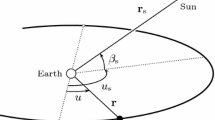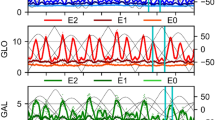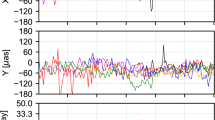Abstract
Systematic errors at harmonics of the GPS draconitic year have been found in diverse GPS-derived geodetic products like the geocenter \(Z\)-component, station coordinates, \(Y\)-pole rate and orbits (i.e. orbit overlaps). The GPS draconitic year is the repeat period of the GPS constellation w.r.t. the Sun which is about 351 days. Different error sources have been proposed which could generate these spurious signals at the draconitic harmonics. In this study, we focus on one of these error sources, namely the radiation pressure orbit modeling deficiencies. For this purpose, three GPS+GLONASS solutions of 8 years (2004–2011) were computed which differ only in the solar radiation pressure (SRP) and satellite attitude models. The models employed in the solutions are: (1) the CODE (5-parameter) radiation pressure model widely used within the International GNSS Service community, (2) the adjustable box-wing model for SRP impacting GPS (and GLONASS) satellites, and (3) the adjustable box-wing model upgraded to use non-nominal yaw attitude, specially for satellites in eclipse seasons. When comparing the first solution with the third one we achieved the following in the GNSS geodetic products. Orbits: the draconitic errors in the orbit overlaps are reduced for the GPS satellites in all the harmonics on average 46, 38 and 57 % for the radial, along-track and cross-track components, while for GLONASS satellites they are mainly reduced in the cross-track component by 39 %. Geocenter \(Z\)-component: all the odd draconitic harmonics found when the CODE model is used show a very important reduction (almost disappearing with a 92 % average reduction) with the new radiation pressure models. Earth orientation parameters: the draconitic errors are reduced for the \(X\)-pole rate and especially for the \(Y\)-pole rate by 24 and 50 % respectively. Station coordinates: all the draconitic harmonics (except the 2nd harmonic in the North component) are reduced in the North, East and Height components, with average reductions of 41, 39 and 35 % respectively. This shows, that part of the draconitic errors currently found in GNSS geodetic products are definitely induced by the CODE radiation pressure orbit modeling deficiencies.









Similar content being viewed by others
Notes
Over all the draconitic harmonics and weighted with the average values of solutions 1 and 3 such that small draconitic errors also have small contributions to the final average.
The \(RSW\) components are defined as: radial \((R)\), along-track \((S)\) and cross-track \((W)\).
The analysis strategy summaries can be found at: ftp://igscb.jpl.nasa.gov/pub/center/analysis/.
References
Amiri-Simkooei AR (2007) Least-squares variance component estimation: theory and GPS applications. PhD thesis, Delf University of Technology, Publications on Geodesy 64, Netherlands Geodetic Commission, http://www.ncg.knaw.nl/Publicaties/Geodesy/pdf/64AmiriSimkooei
Amiri-Simkooei AR (2013) On the nature of GPS draconitic year periodic pattern in multivariate position time series. J Geophys Res 118(5):2500–2511. doi:10.1002/jgrb.50199
Bar-Sever YE (1996) A new model for GPS yaw attitude. J Geod 70(11):714–723. doi:10.1007/BF00867149
Bar-Sever Y, Kuang D (2004) New empirically derived solar radiation pressure model for GPS Satellites. In: Interplanetary Network Progress Report, vol 42–159, http://ipnpr.jpl.nasa.gov/progress_report/42-159/title.htm
Beutler G, Brockmann E, Gurtner W, Hugentobler U, Mervart L, Rothacher M, Verdun A (1994) Extended orbit modeling techniques at the CODE processing center of the International GPS Service for Geodynamics (IGS): theory and initial results. Manuscr Geod 19(6):367–386
Bizouard C, Gambis D (2009) The Combined Solution C04 for Earth Orientation Parameters Consistent with International Reference Frame 2005. In: Drewes H (ed) Geodetic Reference Frames, IAG Symposia 134, Springer, pp 265–270, doi:10.1007/978-3-642-00860-3_41
Collilieux X, Altamimi Z, Coulot D, Ray J, Sillard P (2007) Comparison of very long baseline interferometry, GPS, and satellite laser ranging height residuals from ITRF2005 using spectral and correlation methods. J Geophys Res 112(B12403). doi:10.1029/2007JB004933
Dach R, Hugentobler U, Fridez P, Meindl M (2007) Bernese GPS Software, Version 5.0. Astronomical Institute, University of Bern
Dach R, Brockmann E, Schaer S, Beutler G, Meindl M, Prange L, Bock H, Jäggi A, Ostini L (2009) GNSS processing at CODE: status report. J Geod 83(3–4):353–365. doi:10.1007/s00190-008-0281-2
Dilssner F (2010) GPS IIF-1 satellite antenna phase center and attitude modeling. Inside GNSS 5(6):59–64
Dilssner F, Springer T, Gienger G, Dow J (2011) The GLONASS-M satellite yaw-attitude model. Adv Space Res 47(1):160–171. doi:10.1016/j.asr.2010.09.007
Dow JM, Neilan RE, Rizos C (2009) The International GNSS Service in a changing landscape of Global Navigation Satellite Systems. J Geod 83(3–4):191–198. doi:10.1007/s00190-008-0300-3
Fritsche M, Sosnica K, Rodriguez-Solano CJ, Steigenberger P, Wang K, Dietrich R, Dach R, Hugentobler U, Rothacher M (2014) Combined reprocessing of GPS, GLONASS and SLR Observations. J Geod, in press
Gobinddass ML, Willis P, de Viron O, Sibthorpe A, Zelensky NP, Ries JC, Ferland R, Bar-Sever Y, Diament M, Lemoine FG (2009) Improving DORIS geocenter time series using an empirical rescaling of solar radiation pressure models. Adv Space Res 44(11):1279–1287. doi:10.1016/j.asr.2009.08.004
Griffiths J, Ray JR (2013) Sub-daily alias and draconitic errors in the IGS orbits. GPS Solut 17(3):413–422. doi:10.1007/s10291-012-0289-1
Hugentobler U, van der Marel H, Springer T (2006) Identification and mitigation of GNSS errors. In: Springer T, Gendt G, Dow JM (eds) The International GNSS Service (IGS): perspectives and visions for 2010 and beyond, IGS Workshop 2006
King MA, Watson CS (2010) Long GPS coordinate time series: multipath and geometry effects. J Geophys Res 115(B04403). doi:10.1029/2009JB006543
Kouba J (2009) A simplified yaw-attitude model for eclipsing GPS satellites. GPS Solut 13(1):1–12. doi:10.1007/s10291-008-0092-1
Meindl M (2011) Combined analysis of observations from different global navigation satellite systems. PhD thesis, Astronomisches Institut der Universität Bern, Geodätisch-geophysikalische Arbeiten in der Schweiz, vol 83, http://www.sgc.ethz.ch/sgc-volumes/sgk-83
Meindl M, Beutler G, Thaller D, Dach R, Jäggi A (2013) Geocenter coordinates estimated from GNSS data as viewed by perturbartion theory. Adv Space Res 51(7):1047–1064. doi:10.1016/j.asr.2012.10.026
Ostini L (2012) Analysis and quality assessment of GNSS-derived parameter time series. PhD thesis, Astronomisches Institut der Universität Bern, http://www.bernese.unibe.ch/publist/2012/phd/diss_lo_4print.pdf
Press W, Teukolsky S, Vetterling W, Flannery B (1992) Numerical recipes in Fortran 77: the art of scientific computing, 2nd edn. Cambridge University Press, Cambridge, New York, Melbourne
Ratcliff JT, Gross RS (2013) Combinations of Earth orientation measurements: SPACE2011, COMB2011 and POLE2011. JPL Publication 13–5, Jet Propulsion Laboratory, California Institute of Technology, ftp://euler.jpl.nasa.gov/keof/combinations/2011/SpaceCombPole2011
Ray J, Altamimi Z, Collilieux X, van Dam T (2008) Anomalous harmonics in the spectra of GPS position estimates. GPS Solut 12(1):55–64. doi:10.1007/s10291-007-0067-7
Rebischung P, Altamimi Z, Springer T (2014) A collinearity diagnosis of the GNSS geocenter determination. J Geod 88(1):65–85. doi:10.1007/s00190-013-0669-5
Rodriguez-Solano CJ, Hugentobler U, Steigenberger P, Lutz S (2012a) Impact of Earth radiation pressure on GPS position estimates. J Geod 86(5):309–317. doi:10.1007/s00190-011-0517-4
Rodriguez-Solano CJ, Hugentobler U, Steigenberger P (2012b) Adjustable box-wing model for solar radiation pressure impacting GPS satellites. Adv Space Res 49(7):1113–1128. doi:10.1016/j.asr.2012.01.016
Rodriguez-Solano CJ, Hugentobler U, Steigenberger P, Allende-Alba G (2013) Improving the orbits of GPS block IIA satellites during eclipse seasons. Adv Space Res 52(8):1511–1529. doi:10.1016/j.asr.2013.07.013
Rothacher M, Beutler G, Herring TA, Weber R (1999) Estimation of nutation using the Global Positioning System. J Geophys Res 104(B3):4835–4859. doi:10.1029/1998JB900078
Santamaría-Gómez A, Bouin MN, Collilieux X, Wöppelmann G (2011) Correlated erros in GPS position time series: Implications for velocity estimates. J Geophys Res 116(B01405). doi:10.1029/2010JB007701
Seitz M, Angermann D, Bloßfeld M, Drewes H, Gerstl M (2012) The 2008 DGFI realization of the ITRS: DTRF2008. J Geod 86(12):1097–1123. doi:10.1007/s00190-012-0567-2
Sibthorpe A, Bertiger W, Desai SD, Haines B, Harvey N, Weiss JP (2011) An evaluation of solar radiation pressure strategies for the GPS constellation. J Geod 85(8):505–517. doi:10.1007/s00190-011-0450-6
Tregoning P, Watson C (2009) Atmospheric effects and spurious signals in GPS analysis. J Geophys Res 114(B09403). doi:10.1029/2009JB006344
Tregoning P, Watson C (2011) Correction to “Atmospheric effects and spurious signals in GPS analysis”. J Geophys Res 116(B02412). doi:10.1029/2010JB008157
Wu X, Ray J, van Dam T (2012) Geocenter motion and its geodetic and geophysical implications. J Geodyn 58:44–61. doi:10.1016/j.jog.2012.01.007
Zumberge JF, Heflin MB, Jefferson DC, Watkins MM, Webb FH (1997) Precise point positioning for the effcient and robust analysis of GPS data from large networks. J Geophys Res 102(B3):5005–5017. doi:10.1029/96JB03860
Acknowledgments
This work has been funded by the DFG projects “LEO orbit modeling improvement and application for GNSS and DORIS LEO satellites” and “Geodätische und geodynamische Nutzung reprozessierter GPS-, GLONASS- und SLR-Daten”.
Author information
Authors and Affiliations
Corresponding author
Rights and permissions
About this article
Cite this article
Rodriguez-Solano, C.J., Hugentobler, U., Steigenberger, P. et al. Reducing the draconitic errors in GNSS geodetic products. J Geod 88, 559–574 (2014). https://doi.org/10.1007/s00190-014-0704-1
Received:
Accepted:
Published:
Issue Date:
DOI: https://doi.org/10.1007/s00190-014-0704-1




